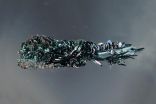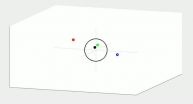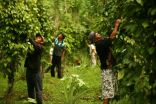(Press-News.org) Around 85% of the matter in the Universe is dark [1], and of a type not understood by physicists. Although it doesn't shine or absorb light, astronomers can detect this dark matter through its effect on stars and galaxies, specifically from its gravitational pull. A major project using ESO's powerful survey telescopes is now showing more clearly than ever before the relationships between this mysterious dark matter and the shining galaxies that we can observe directly [2].
The project, known as the Kilo-Degree Survey (KiDS - http://kids.strw.leidenuniv.nl/), uses imaging from the VLT Survey Telescope and its huge camera, OmegaCAM. Sited at ESO's Paranal Observatory in Chile, this telescope is dedicated to surveying the night sky in visible light -- and it is complemented by the infrared survey telescope VISTA . One of the major goals of the VST is to map out dark matter and to use these maps to understand the mysterious dark energy that is causing our Universe's expansion to accelerate.
The best way to work out where the dark matter lies is through gravitational lensing -- the distortion of the Universe's fabric by gravity, which deflects the light coming from distant galaxies far beyond the dark matter. By studying this effect it is possible to map out the places where gravity is strongest, and hence where the matter, including dark matter, resides.
As part of the first cache of papers, the international KiDS team of researchers, led by Koen Kuijken at the Leiden Observatory in the Netherlands [3], has used this approach to analyse images of over two million galaxies, typically 5.5 billion light-years away [4]. They studied the distortion of light emitted from these galaxies, which bends as it passes massive clumps of dark matter during its journey to Earth.
The first results come from only 7% of the final survey area and concentrate on mapping the distribution of dark matter in groups of galaxies. Most galaxies live in groups -- including our own Milky Way, which is part of the Local Group -- and understanding howmuch dark matter they contain is a key test of the whole theory of how galaxies form in the cosmic web. From the gravitational lensing effect, these groups turn out to contain around 30 times more dark than visible matter.
"Interestingly, the brightest galaxy nearly always sits in the middle of the dark matter clump," says Massimo Viola (Leiden Observatory, the Netherlands) lead author of one of the first KiDS papers.
"This prediction of galaxy formation theory, in which galaxies continue to be sucked into groups and pile up in the centre, has never been demonstrated so clearly before by observations," adds Koen Kuijken.
The findings are just the start of a major programme to exploit the immense datasets coming from the survey telescopes and the data are now being made available to scientists worldwide through the ESO archive.
The KiDS survey will help to further expand our understanding of dark matter. Being able to explain dark matter and its effects would represent a major breakthrough in physics.
INFORMATION:
Notes
[1] Astronomers have found that the total mass/energy content of the Universe is split in the proportions 68% dark energy, 27% dark matter and 5% "normal" matter. So the 85% figure relates to the fraction of "matter" that is dark.
[2] Supercomputer calculations show how a Universe filled with dark matter will evolve: over time dark matter will clump into a huge cosmic web structure, and galaxies and stars form where gas is sucked into the densest concentrations of dark matter.
[3] The international KiDS team of researchers includes scientists from the Netherlands, the UK, Germany, Italy and Canada.
[4] This work made use of the 3D map of galaxy groups, provided by the Galaxy And Mass Assembly project (GAMA - http://www.gama-survey.org/ ), following extensive observations on the Anglo-Australian Telescope.
More information
This research was presented in a series of papers submitted to several leading journals. A list can be found here: http://kids.strw.leidenuniv.nl/papers.php .
ESO is the foremost intergovernmental astronomy organisation in Europe and the world's most productive ground-based astronomical observatory by far. It is supported by 16 countries: Austria, Belgium, Brazil, the Czech Republic, Denmark, France, Finland, Germany, Italy, the Netherlands, Poland, Portugal, Spain, Sweden, Switzerland and the United Kingdom, along with the host state of Chile. ESO carries out an ambitious programme focused on the design, construction and operation of powerful ground-based observing facilities enabling astronomers to make important scientific discoveries. ESO also plays a leading role in promoting and organising cooperation in astronomical research. ESO operates three unique world-class observing sites in Chile: La Silla, Paranal and Chajnantor. At Paranal, ESO operates the Very Large Telescope, the world's most advanced visible-light astronomical observatory and two survey telescopes. VISTA works in the infrared and is the world's largest survey telescope and the VLT Survey Telescope is the largest telescope designed to exclusively survey the skies in visible light. ESO is a major partner in ALMA, the largest astronomical project in existence. And on Cerro Armazones, close to Paranal, ESO is building the 39-metre European Extremely Large Telescope, the E-ELT, which will become "the world's biggest eye on the sky".
Links
* Links to research papers: http://kids.strw.leidenuniv.nl/papers.php
* Photos of the VST: http://www.eso.org/public/images/archive/search/?adv=&subject_name=VLT%20Survey%20Telescope
Contacts
Koen Kuijken
Leiden Observatory
Leiden, The Netherlands
Email: kuijken@strw.leidenuniv.nl
Massimo Viola
Leiden Observatory
Leiden, The Netherlands
Email: viola@strw.leidenuniv.nl
Lars Lindberg Christensen
Head of ESO ePOD
Garching bei München, Germany
Tel: +49 89 3200 6761
Cell: +49 173 3872 621
Email: lars@eso.org
Childhood high blood pressure (HBP) is a serious public health challenge worldwide due to associated increases in risk of end organ damages and correlation with HBP in adulthood. The prevalence of elevated blood pressure (BP) has been reported to increase significantly among United States children and adolescents from 1988-1994 to 1999-2008, but little is known about recent trends in BP values and elevated BP. The authors of a new study, "Trends in elevated blood pressure among US children and adolescents: 1999-2012," published today by the American Journal of Hypertension, ...
ANN ARBOR--University of Michigan researchers and their colleagues predict that the 2015 western Lake Erie harmful algal bloom season will be among the most severe in recent years and could become the second-most severe behind the record-setting 2011 bloom.
The 2015 seasonal forecast uses models that translate spring nutrient loading into predicted algal blooms in the Western Basin of Lake Erie. After a relatively dry April and May, the heavy rains in June produced record discharge and nutrient loadings from the Maumee River, which runs through Toledo and northeastern ...
This news release is available in German.
Graphene, the only one atom thick carbon network, achieved overnight fame with the 2010 Nobel Prize. But now comes competition: Such layers can also be formed by black phosphorous. Chemists at the Technische Universität München (TUM) have now developed a semiconducting material in which individual phosphorus atoms are replaced by arsenic. In a collaborative international effort, American colleagues have built the first field-effect transistors from the new material.
For many decades silicon has formed the ...
Chicago - Although opioids are frequently prescribed to treat chronic lower back pain, new research suggests these powerful medications may be less effective in some patients. A study published in the Online First edition of Anesthesiology, the official medical journal of the American Society of Anesthesiologists® (ASA®), found patients who were prescribed opioids to treat chronic lower back pain experienced significantly less pain relief and were more likely to abuse their medication when they had psychiatric disorders such as depression or anxiety.
"High levels ...
Neuroscientists at Duke University have introduced a new paradigm for brain-machine interfaces that investigates the physiological properties and adaptability of brain circuits, and how the brains of two or more animals can work together to complete simple tasks.
These brain networks, or Brainets, are described in two articles to be published in the July 9, 2015, issue of Scientific Reports. In separate experiments reported in the journal, the brains of monkeys and the brains of rats are linked, allowing the animals to exchange sensory and motor information in real time ...
The human eye is an amazing instrument and can accurately distinguish between the tiniest, most subtle differences in color. Where human vision excels in one area, it seems to fall short in others, such as perceiving minuscule details because of the natural limitations of human optics.
In a paper published today in The Optical Society's new, high-impact journal Optica, a research team from the University of Stuttgart, Germany and the University of Eastern Finland, Joensuu, Finland, has harnessed the human eye's color-sensing strengths to give the eye the ability to ...
UBC research shows world's monitored seabird populations have dropped 70 per cent since the 1950s, a stark indication that marine ecosystems are not doing well.
Michelle Paleczny, a UBC master's student and researcher with the Sea Around Us project, and co-authors compiled information on more than 500 seabird populations from around the world, representing 19 per cent of the global seabird population. They found overall populations had declined by 69.6 per cent, equivalent to a loss of about 230 million birds in 60 years.
"Seabirds are particularly good indicators of ...
Chemotherapy treatment usually involves the patient receiving medicine through an intravenous catheter. These catheters, as well as the the equipment attached to them, are treated with a silver coating which is antibacterial, preventing bacterial growth and unwanted infections during a treatment.
Researchers at the Norwegian University of Science and Technology's (NTNU) Department of Physics are now studying what happens when different drugs come in contact with this silver coating.
Silver breaks down chemotherapy drugs
"We wanted to find potential problem sources ...
This news release is available in German.
Although global concentration of greenhouse gases in the atmosphere has continuously increased over the past decade, the mean global surface temperature has not followed the same path. A team of international reseachers, KIT scientists among them, have now found an explanation for this slowing down in global warming: the incoming solar radiation in the years 2008-2011 was twice as much reflected by volcanic aerosol particles in the lowest part of the stratosphere than previously thought. The team presents their study ...
In a recent article in Nature, Keith Shepherd and the Land Health Decisions team at the World Agroforestry Centre (ICRAF), together with their external partners, propose a radically new method to the SDG community that would answer these questions. They call on the United Nations and private sector to dispense with the highly criticized target setting approach and adopt the new method of decision analysis.
The target setting approach is widely seen as ineffective or counter-productive. Targeting emphasizes meeting a 'target' rather than learning how to improve performance ...






